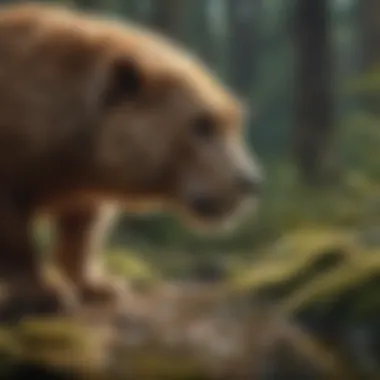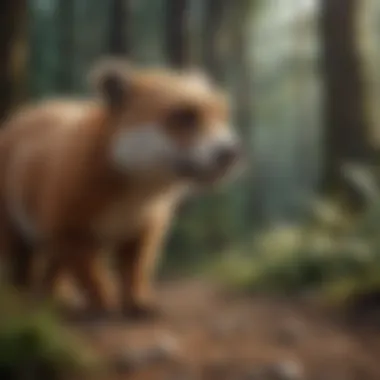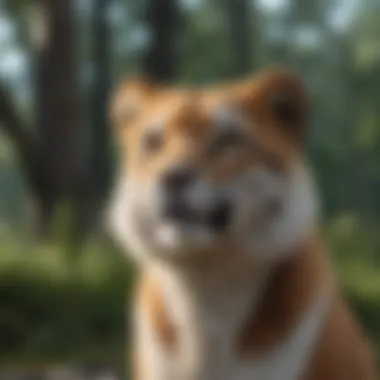Discovering the Fun of Animal Imagery for Kids


Intro
The charming world of animal imagery is not just about cute kittens or playful puppies. It digs deeper into how these visuals can spark curiosity and learning in children. From the tiny meerkat peeking out of its burrow to the great blue whale gliding through the ocean, every image tells a story. The use of animal imagery in educational settings can significantly enhance a child’s understanding of different species, their habitats, and behaviors. It captivates their imagination and opens up avenues for exploration, igniting a passion for the natural world around them.
Nature Topic Overview
When we talk about animal imagery, it’s easy to get lost in a sea of cute pictures either gracing the pages of a children's book or filling a screen. But the significance runs much deeper. This section is about how animal pictures can entertain while also serving an educational purpose. Our goal is to create a bridge between visual stimulus and knowledge, fostering a love for nature among children aged five to twelve.
Images of animals can act as windows where kids can observe behavior, discern colors and patterns, and even learn about habitats. Unlike a standard text-heavy lesson, these visuals can hold a child’s attention, strengthen memory retention, and encourage deeper engagement.
"A picture is worth a thousand words" rings true especially in the case of animal images, where the right visuals can invoke a sense of wonder and understanding.
Fun Facts and Trivia
Every animal has its unique quirks that can make learning fun! Here are some interesting tidbits to pique the interest of young readers:
- Did you know that octopuses have three hearts? Two pump blood to the gills while one pumps it to the rest of the body.
- The blue whale isn't just massive; it’s also the loudest animal on Earth! Its calls can be heard from over 500 miles away.
- Some frogs can freeze without dying! They enter a state called cryobiosis, which allows them to survive harsh winters.
Using visuals alongside these fun facts helps solidify the information. Bright, colorful animations or photos can keep attention and prompt older kids to ask more questions.
Wildlife Explorations
Exploring different species is like opening a treasure chest filled with wonders. Each animal comes with its story. For instance, let’s dive into the unique world of sea turtles:
- Green Sea Turtle: Known for their friendly demeanor, these reptiles can live to be over 80 years old!
- Leatherback Turtle: The largest of all sea turtles, they can weigh more than a ton and are known for their jellyfish diet.
Children can learn about their habitats, behaviors, and even their migration patterns. Interactive quizzes or puzzles can highlight key aspects of their lives, such as feeding habits and predator threats.
Environmental Awareness
As kids learn about these animals, they should also understand the importance of protecting them. The staggering decline in wildlife due to climate change and habitat loss should not be ignored. Piano-key forests or coral reefs are not just pretty sights; they are crucial ecosystems. Teaching children can empower them to make a difference.
Here are some simple actions kids can take to help:
- Reduce plastic usage: Encourage the use of reusable bags and bottles.
- Create a small garden: Planting native species can attract local wildlife, supporting the ecosystem around them.
- Participate in local cleanup drives: It’s hands-on and shows that every bit counts.
DIY Nature Activities
Getting hands dirty with nature is often the best way to learn! Here are some activities:
- Nature Collage: Gather leaves, flowers, and twigs to create a beautiful artwork that reflects their local ecosystem.
- Animal Tracking: Take a walk and observe animal tracks. Identify the animals that have crossed their path.
- DIY Bird Feeders: Use pine cones, peanut butter, and seeds to create feeders that attract local birds, allowing children to observe and learn.
In short, animal imagery is much more than mere content. It’s a tool that enriches children's understanding of the world and fosters an appreciation for nature, proving that pictures can indeed make a lasting impact.
Prologue to Animal Imagery
Animal imagery has become a fascinating lens through which we can view the natural world. It resonates with audiences of all ages, but is particularly captivating for children aged five to twelve. In this age group, imagination knows no bounds, and the visual representation of animals can stimulate curiosity that fosters a love for the environment.
Understanding animal imagery encompasses not just the charming and often humorous visuals, but the underlying messages about biodiversity and our responsibility towards wildlife. When kids laugh at a picture of a panda taking a nap or a dog wearing glasses, they’re not just entertained; they’re absorbing information, whether it’s about endangered species or just the quirky habits of animals. This dual purpose—entertainment and education—is pivotal in the realm of animal representation.
The Role of Humor in Nature
Humor plays a vital role in how young learners perceive and connect with the animal kingdom. Imagine a cartoonish dolphin jumping out of a wave with a party hat on; it instantly prompts giggles and captures attention. This portrayal helps in easing the learning process, making difficult topics like conservation or animal behavior approachable and engaging. Kids are natural comedians themselves, so they easily resonate with playful imagery.
Humor can build an emotional bridge between children and animals. By humanizing animals through funny images, children often develop empathy towards them. It’s one thing to see a majestic tiger in a zoo; it’s a whole other experience to see one in a silly trope. This connection is essential for adults too, as they observe how children relate to the imagery, drawing parallels about their own lives and experiences.
Why Animal Pictures Capture Attention
The curious nature of kids makes them excellent visual learners. Pictures of animals can not only intrigue their imagination but also promote active engagement. Bright colors, unusual poses, or even animals acting like humans can provoke discussions that deepen understanding of wildlife.


This captivated attention comes with several contributory factors:
- Vivid Imagery: The more colorful and dynamic the picture, the easier it is for kids to remember. An alligator in a crown is far more compelling than a basic wildlife image.
- Relatability: Children often see themselves in the stories behind animal pictures. Whether it’s a pair of kittens play-fighting or a bear fishing for salmon, these scenarios mirror their experiences, making them more relatable and easier to understand.
- Stories and Imagination: Each animal image can spark stories in a child’s mind. For instance, a picture of a dog with a skateboard might inspire a tale about adventure and friendship. This imaginative extension drastically enhances the educational value of the picture because it integrates creativity and narrative thinking.
Types of Animal Imagery
Animal imagery comes in various shapes and forms, each with its unique flair and charm. Understanding these different types is crucial for comprehending how they can effectively engage and educate children, as well as foster a greater appreciation for the natural world. From photos that capture the raw beauty of wildlife to whimsical drawings that tickle the imagination, each approach offers distinct benefits and considerations that can enhance learning experiences.
Photographs Versus Illustrations
When considering animal imagery, one must weigh the merits of photographs and illustrations. Photographs are often celebrated for their authentic representation of animals in their natural environments, showcasing intricate details that can amaze young minds. Think about the vibrancy of a parrot perched on a branch or a lion lounging in the sun—these images can draw in curious gazes and spark conversations.
On the other hand, illustrations can offer a playful touch. Artists can exaggerate features or play with colors, creating characters that are larger than life. This can aid in storytelling or educational use, allowing children to grasp complex concepts or behaviors without being overwhelmed by the nuances of reality. Both formats have their place, and incorporating a blend can cater to various learning styles.
"Imagery that resonates can ignite a spark of curiosity in young minds."
Realistic Imagery in Education
Realistic imagery serves as a powerful teaching tool. In educational settings, keeping the characteristics of animals true to life assists students in forming accurate mental models. When children see a depiction of an elephant's trunk or the stripes of a zebra, they can begin to understand how these traits serve a purpose in nature, such as for feeding or camouflage.
Moreover, realistic images help students in science-related subjects, bridging the gap between theory and observable phenomena. For instance, when discussing habitats, realistic photographs underscore the connection between animals and their environments, allowing children to visualize and contextualize their learning.
Cartoonish Representations
Cartoonish representations can be a delightful way to introduce children to animal imagery. These playful depictions often feature exaggerated traits, like a turtle sporting sunglasses or a cat gossiping with a bird. Such imagery not only entertains but also softens the introduction of more serious ecological or behavioral concepts.
Cartoons can simplify complex behaviors and make them relatable. For example, by depicting a squirrel sneaking food as a funny character, children's understanding of animal behaviors such as foraging becomes more accessible. It keeps the tone light while subtly imparting lessons about the animal kingdom, making it easier for young learners to grasp.
In essence, exploring the different types of animal imagery allows educators and parents to craft richer, more engaging learning experiences. Each method—whether realistic or cartoonish—brings its strengths to the table. This variety can cater to diverse learning preferences, ensuring that the captivating world of animals is both informative and entertaining.
Educational Benefits of Animal Photography
Animal photography isn't just about capturing cute or funny moments; it often serves a deeper educational purpose. This approach encourages children to explore their environment and learn about the diverse species that share our planet. Through vivid photographs and engaging imagery, we can pique the curiosity of young minds and nurture a more profound understanding of nature's intricacies. Consistent exposure to well-crafted animal imagery can develop children's fascination for wildlife, driving them to question, learn, and appreciate the natural world.
Stimulating Curiosity and Learning
When children see striking images of animals, their imaginations are ignited. A photograph of a playful dolphin leaping through the air or a cheeky monkey swinging from tree to tree often sparks questions, such as "How do dolphins leap so high?" or "What are monkeys eating in the wild?" These questions create a natural path for learning. Children, who are innately curious, are motivated to seek answers.
- Animals as observation tools: Engaging visuals perfectly complement various educational activities. For instance, instead of simply explaining the concept of symbiosis, educators can showcase a photograph of a clownfish hosted by a sea anemone. This visual representation solidifies abstract concepts, making them more comprehensible and relatable.
- Encouragement through online platforms: Parents can also support this exploration. Sharing fun animal pictures on social media platforms such as Facebook or engaging with animal communities on Reddit can further develop children’s interest and provide a plethora of information from others who share their enthusiasm.
Understanding Animal Behavior
Images do a fantastic job of portraying animals in their natural habitats, contributing to an understanding of animal behavior. Take, for example, an image of a fox stalking through snowy woods. This particular sight can lead to discussions about hunting techniques, survival strategies, and adaptability in various environments. By observing animal interactions in a photograph, children learn vital aspects of life in the wild, such as:
- Social behavior: Pictures showing animals in packs or families reveal how they communicate and cooperate with one another.
- Adaptation: Photographs of animals like polar bears swimming or camouflaging themselves demonstrate physical adaptions in response to their environment.
As children uncover these behaviors through visuals, they begin to grasp complex biological concepts, making them more likely to remember information.
Enhancing Retention and Memory
The visual component of animal photography plays a critical role in memory retention. Studies consistently show that people retain information better when they have a visual association to it. When an image is paired with an educational concept, it tends to stick in the memory longer. A psychology principle called dual coding suggests that when we process information in more than one way (visually and verbally), our understanding deepens.
- Memory techniques: For instance, if children are taught about migration using dynamic images of birds flying in formation, they can recall this information more easily compared to reading text alone. The visual representation complements the discussion, ingraining learning in their minds.
- Interactive resources: Many educational apps incorporate animal imagery as part of games or quizzes, encouraging children to connect with facts about animals they may not have previously considered. Utilizing such tools helps enhance their retention even further.
Overall, animal photography plays a pivotal role in children's education, stimulating curiosity, enhancing understanding of behaviors, and promoting memory retention. By leveraging the beauty and humor of animal imagery, we foster an engaging learning environment that nurtures young minds.
The Psychological Impact of Animal Imagery
Animal imagery plays a crucial role in shaping how individuals—especially children—perceive and engage with the world around them. The way we visualize animals can sway our emotions, enhance learning, and foster connections that are both profound and lasting. This section delves into the importance of understanding the psychological impact behind the visuals, exploring how humor and emotional relationships contribute to educational experiences for children.


Humor as a Learning Tool
Using humor in the context of animal imagery serves as a unique bridge between entertainment and education. When children encounter funny animal pictures, it activates their natural curiosity and willingness to learn. For instance, a photo of a dog wearing oversized sunglasses can elicit laughter, sparking interest about various dog breeds or their behaviors.
This light-hearted approach can help reinforce subjects that might otherwise seem monotonous or difficult to grasp. The laughter generated can ease anxiety, making a child more receptive to a lesson about animal habitats or survival tactics. Some ways humor operates as a learning tool include:
- Increased Engagement: When children laugh, they become more involved. Visuals that highlight playful scenarios pique their interest and make them want to know more.
- Memory Aids: Humorous images often stick in a child’s mind longer than a standard picture of the animal. This is partly because laughter and pleasure enhance memory retention.
- Facilitating Discussions: Funny animal pictures often become conversation starters. This creates opportunities for parents and educators to discuss more serious topics, such as conservation or animal rights, founded on a base of humor.
"Humor can be a powerful tool that breaks down barriers and opens up pathways to knowledge."
Emotional Connections with Animals
The bond that children form with animals depicted in imagery can be deeply emotional. Kids are often drawn to images that resonate with feelings of compassion or empathy. For example, a photograph of a baby elephant with big, soulful eyes can evoke feelings of tenderness and concern for wildlife preservation among young viewers. This emoptional connection fosters a respectful understanding of the creatures inhabiting our planet.
Encouraging these emotional responses has several notable effects:
- Developing Empathy: When children relate to animals on an emotional level, they learn compassion. Understanding that animals can experience joy, fear, and pain cultivates a sense of empathy that can extend beyond the animal kingdom.
- Inspiring Action: Emotional engagement can inspire children to participate in conservation efforts or animal welfare initiatives. A child who feels connected to an endangered species may be more likely to engage in activities aimed at protecting it.
- Social Skills Growth: Discussing emotional responses to animal imagery with peers or adults fosters communication skills. It teaches kids to express their feelings and understand those of others, a vital skill as they grow.
Delving into the psychological impacts of animal imagery reveals its potential to create a more compassionate and educated generation. Understanding both humor and emotional connections allows guardians and educators to harness the power of animal visuals effectively and meaningfully.
Creative Uses of Animal Imagery in Education
In the exploration of animal imagery within an educational context, creativity becomes the heartbeat of engagement. When animal images are incorporated into educational materials, they serve as more than just pretty pictures; they become powerful tools for learning. The charm of animal imagery lies in its ability to simplify complex ideas and make them accessible to young minds. This kind of visual learning can spark curiosity, foster discussions and bring lessons to life.
Incorporating Images into Lesson Plans
Integrating animal imagery into lesson plans is an effective way to capture students' attention and enhance their understanding of various subjects. Rather than relying solely on text-heavy materials, using visuals can truly bring subjects to life.
- Visual Learning: Studies have shown that students often retain information better when it is paired with compelling images. An image of a lion, for instance, might not just teach about animals but also touch on geography, culture, and conservation efforts.
- Engagement Boost: Animals can instantly pique a child’s interest. Consider the difference between asking students to read about the anatomy of a dolphin and inviting them to analyze vivid images of dolphins while learning about their habitats and behaviors.
Incorporating images doesn’t merely enrich lessons; it can enhance creativity, too. For instance, math lessons can be adorned with images of animals in various poses – counting the legs of insects or the spots on a leopard as a fun way to introduce addition or patterns.
Using Animal Pictures for Storytelling
Animal imagery can play a significant role in storytelling, where the visuals weave seamlessly into the narrative fabric of a lesson or activity. Children typically relate to stories that feature animals, which can help unlock their imagination. Here are a few ways to leverage animal pictures in storytelling:
- Building Stories: Use animal images as prompts to encourage children to craft their own stories. For example, displaying a photo of a curious raccoon could inspire tales of adventure or mischief.
- Enhancing Retention: When children visualize animals interacting in different scenarios, they are likely to remember the underlying concepts better. For example, if a story talks about teamwork, visuals of animals working together can underline the message in a relatable way.
By transforming a simple story into a visual experience, educators can facilitate a deeper emotional connection between the young learners and the material, enriching their overall educational journey.
Creating Art from Animal Imagery
Art is yet another avenue where animal imagery can take shape to inspire children. When students use animal pictures as a basis for their own art, it opens a gateway to self-expression and creativity. This can come in many forms:
- Drawing and Painting: Children might replicate their favorite animal images or create whimsical interpretations inspired by actual creatures. Such activities can not only hone fine motor skills but also nurture a sense of individuality and artistic voice.
- Collage Projects: Using mixed media with animal images allows for the exploration of textures and colors, cultivating an appreciation for nature's beauty. Artists of all ages can cut, paste, and piece together various images to tell their own stories.
Moreover, such artistic endeavors often lead to discussions about the animals themselves, bringing up important educational themes like habitats, environments, and conservation.
"Animals have the power to inspire creativity. Their images spark curiosity and invite children into a world where learning is as colorful as a peacock's tail."
In closing, the creative uses of animal imagery in education serve as a bridge to understanding and appreciating the natural world. By turning lessons into visual and imaginative experiences, educators can engage children on multiple levels, fostering a deep-seated love for learning that is both amusing and enlightening.
The Role of Technology in Sharing Animal Images
In this digital age, the role of technology in sharing animal imagery is becoming increasingly significant. It allows not just for the dissemination of information, but for the creation of connections through shared experiences, especially among children. Through various online platforms and apps, young learners can engage with animal visuals in ways that were unthinkable a few decades ago. This encompasses educational tools that facilitate learning, as well as social media that amplifies the visibility of these images, creating a virtual community around wildlife and nature appreciation.
Social Media and Animal Photography
Social media has transformed how we see and share animal images. Platforms like Facebook and Instagram serve as vibrant galleries, where stunning photographs of animals capture hearts and minds alike. These visuals are often accompanied by stories that breathe life into each creature, making it feel personal.


- Connection: Children can follow wildlife organizations or photographers who specialize in animal imagery. This fosters a sense of connection to the natural world, even from their living rooms.
- Education: Through engaging posts, users can learn fun facts about animals, making the process of discovery interactive and enjoyable. It's not just looking at a picture, but understanding the story behind it.
- Awareness: Campaigns against wildlife poaching, habitat destruction, or environmental issues are often shared in photography projects. Children can learn about these critical topics through engagin media that resonates with them.
Social media can turn a child's casual interest in animals into a passionate pursuit. Just a scroll through a few posts can spark curiosity about how these animals live, and what we can do to protect them.
Apps for Sharing and Creating Animal Art
With smartphones in every hand, numerous apps have popped up that enable the creation and sharing of animal-related art. These tools have proven invaluable in not just promoting creativity but in educating children as well.
- Artistic Expression: Apps like Procreate or Adobe Fresco allow youngsters to draw or modify animal images. They can experiment with colors or styles, nurturing their creative side.
- Educational Games: Many applications incorporate elements of play that teach children about animals. Games that require them to match animals to their habitats or identify species can solidify knowledge through interactive engagement.
- Sharing Platforms: Apps like Flickr or even Pinterest serve as platforms for sharing creations. Children can post their artwork, receive feedback, and even collaborate on projects, bridging the gap between learning and social interaction.
"Technology beautifully blends education and creativity, helping to develop a deeper understanding of animal life for the younger generations."
Challenges in Representing Animals Visually
When we talk about animal imagery, it’s not just about how cute, funny, or playful these representations can be. It's also crucial to understand the practical challenges that artists, educators, and photographers face when they try to depict animals visually. The imagery we create can have a profound effect on how young minds perceive the natural world.
These challenges often stem from our desire to simplify complex realities into easily digestible visuals. While humor and creativity play essential roles in engaging children aged five to twelve, it's not all fun and games. Striking the right balance between educational value and artistic expression can sometimes be a tightrope walk. Ensuring that depictions of animals are accurate and free from stereotypes speaks volumes about our respect for nature and its inhabitants.
Misrepresentation and Stereotypes
One significant issue in animal imagery is the potential for misrepresentation. Over the years, certain animals have fallen victim to stereotypes that don't accurately reflect their behaviors or characteristics. For instance, consider how owls are often portrayed as wise, while their real-life behavior is much more nuanced. Presenting animals through a narrow lens can lead to misconceptions among children, who might then think that all owls possess the same supposed wisdom.
Moreover, misrepresentation can extend to creating harmful stereotypes about certain species. For example, the portrayal of wolves as just ruthless predators overlooks their social structures and roles within eco-systems. If children only see wolves in this way, it can foster fear or misunderstanding, distancing them from the beauty of these creatures.
Here are some considerations to keep in mind:
- Perpetuation of Myths: When animals are shown only as villains, it strengthens already existing myths and can create negative views in young minds.
- Lack of Diversity: Simplified images often ignore the ecological roles different species play, which could otherwise teach children about biodiversity.
- Impact on Conservation: Misrepresentation can discourage appreciation and lead to apathy toward wildlife preservation efforts.
By being mindful of how we represent animals visually, comedy can still provide an avenue for learning without relying on outdated stereotypes. It's important to approach animal imagery with a keen eye, ensuring that what is presented reflects the reality of these living beings.
Ethical Considerations in Wildlife Photography
The world of wildlife photography is not only an artistic endeavor. It comes with a hefty set of ethical considerations that every photographer should bear in mind. Capturing animals in their natural habitats without causing harm or disruption is of the utmost importance.
Consider this: If a photographer ventures too close to a nesting bird to capture the perfect shot, they risk disturbing its habitat and potentially harming the nest's future. Such actions can lead to stress for the animals and may have devastating effects on their populations.
Important ethical considerations include:
- Respect for Wildlife: Photographers must prioritize the well-being of the animals and avoid intruding on their habitats.
- Naturalistic Representation: Images must depict animals within their environments authentically, without tampering with or altering their natural behaviors.
- Informed Consent: Just like with human subjects, obtaining consent in wildlife photography can be as simple as respecting animals’ space and not exploiting them for a more striking image.
As young audiences engage with animal photographs, it's imperative they understand that these visuals do not just appear on a screen or page; they come from real-life situations. Teaching children about ethical wildlife representation fosters a deeper connection to nature and an understanding of the responsibilities that come with it.
The End: The Importance of Animal Imagery
Animal imagery is much more than a fun splash of color or laughter in our lives; it serves a deep function in shaping how young minds connect with their environment. This article has explored how these images can spark interest in the natural world, allowing children to cultivate respect and curiosity about wildlife. Visual representations of animals can become a stepping stone towards understanding ecological systems, conservation, and the bonds that exist in nature.
Encouraging Appreciation of Nature
Animal imagery furthers the fundamental goal of fostering a genuine appreciation for nature. By introducing children to various species—sometimes even in humorous poses—the images become an avenue for exploration. When children see playful pandas or goofy geese, they don't just laugh; they engage. This leads to questions like:
- Why do pandas roll in the snow?
- What makes geese honk in the way they do?
This kind of visual inquiry opens the door to discussions about habitats, behaviors, and the vital role these creatures play in the ecosystem. It invites children to step outside, observe animals in their environment, and build an understanding of biodiversity that is crucial for developing empathetic attitudes towards living beings.
The Future of Animal Imagery in Education
Looking ahead, the future of animal imagery in education appears vibrant and promising. With technology evolving at breakneck speed, children are now more connected than ever. Educational tools that incorporate animal images are becoming increasingly accessible. Think about apps and online platforms where kids can learn about animals in an interactive way.
Imagine a world where children can use augmented reality to 'meet' a cheetah in their living room or tap on a picture to learn fun facts about it. Creating entertaining lesson plans using these tools could make learning easier.
"Animal imagery not only entertains but also shapes critical thinking and emotional connections."
Kids are natural learners. They absorb information effortlessly, especially when presented in engaging ways. The potential for animal imagery to be weaved into curriculums is vast. Educators and parents alike can harness this to create multifaceted educational experiences that build observational skills, critical thinking, and environmental awareness.
In a nutshell, animal imagery is a gift. It opens hearts and minds to the wonders of nature while building foundations for lasting knowledge and appreciation. As we continue to understand its benefits, the role of animal imagery will only grow, bringing more smiles and insight to future generations.







